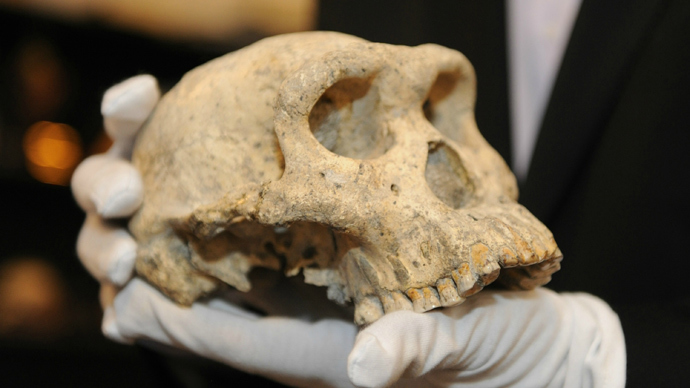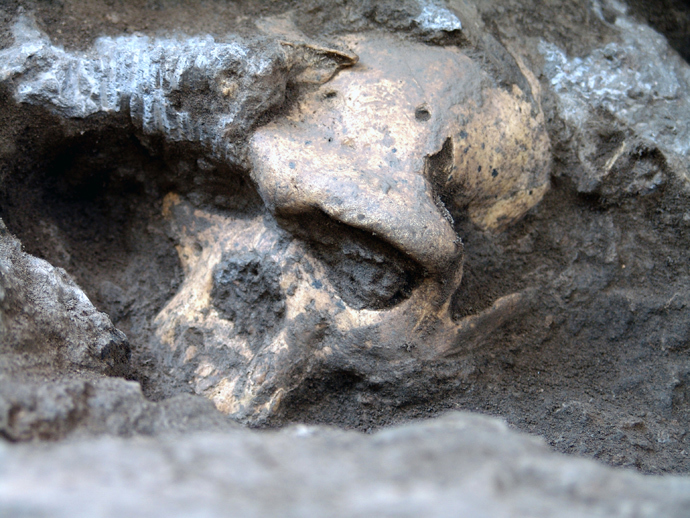‘Homo Georgicus’: Georgia skull may prove early humans were single species

A 1.8 million-year-old skull found in Georgia could turn current understanding of evolution on its head. A new study claims that early man did not come from Africa as seven species, but was actually a single ‘homo erectus’ with variations in looks.
The case revolves around an early human skull found in a
stunningly well-preserved state at an archaeological dig at the
site of the medieval hill city of Dmanisi in Georgia, a study in
the journal Science revealed on Thursday.
Stone tools were found next to the remains, indicating that the species hunted large carnivorous prey, including probably saber-toothed tigers.
A team of scientists spent over eight years studying the find, whose original date of excavation was 2005. Its jawbone was actually discovered back in 2000, but only recently have the parts been assembled to produce a complete skull.
New dating technology allowed scientists to establish that these early humans come from around 1.8 million years ago. Near to the bone fragments were the remains of huge prehistoric predators; the area is next to a river and was full of them, as they encountered humans in fights to the death.
The skull has a tiny brain about a third of the size of our
modern Homo sapiens incarnation; it also has protruding brows,
jutting jaws and other characteristics we have come to expect
from lesser developed prehistoric humans.
But the surprising revelation came when the skull was placed next
to four other skulls discovered within a 100-kilometer radius.
They vary so much in appearance that it brings into question
whether the current understanding of species variation is
correct.
Traditional theories accept a whole plethora of stand-alone species – but the new find strongly hints that the five remains were all one, but with striking differences in bone structure that we have come to expect only from our own ‘complex’ kind.

Director of the Georgian National Museum and lead researcher,
David Lordkipanidze, has come out with the claim that the find is
"the richest and most complete collection of indisputable
early Homo remains from any one site."
"Dmansi is a unique snapshot of time – maybe a time capsule
that preserves things from 1.8 million years ago," he told
AFP.
Adding weight to the new hypothesis, co-author of the study,
Christoph Zollikofer of the University of Zurich, judged that
despite the striking dissimilarities “we know that these
individuals came from the same location and the same geological
time, so they could, in principle, represent a single population
of a single species.”
The differences in the skulls’ eyebrow ridges, jaws and other features were all consistent with what paleontologists expect of variations within the same species.
"The five Dmanisi individuals are conspicuously different from each other, but not more different than any five modern human individuals, or five chimpanzee individuals, from a given population," Zollikofer continued.
This has led scientists to conclude that, while previously we
thought that intra-species variation was an exception, it could
very well be a rule instead.
For decades researchers would separate all types of humans originating in Africa into separate sub-groups – with examples including the Homo habilis, the Homo rudolfensis, and so on. The new hypothesis suggests these could all just be Homo erectus, with the regular human variation in bone structure we witness in our own Homo sapiens peers. 3D modeling shows this clearly.
It also challenges the notion that we needed a larger cranial capacity – or brain – in order to be intelligent enough to use complex tools, hunt large prey and migrate to distant continents. It appears the humans found at the Georgian site actually migrated to Asia despite not being very ‘bright.’
Milford Wolpoff of the University of Michigan told AFP that the team was “thrilled about the conclusion they came to. It backs up what we found as well.” He was working with a colleague from Wellesley College during a study they published a year ago, which also targeted statistical variations in characteristics of skulls from Georgia and East Africa – considered to be one of the cradles of human civilization.
The study suggested active inter-species breeding was commonplace back in those days.
"Everyone knows today you could find your mate from a different continent and it is normal for people to marry outside their local group, outside their religion, outside their culture…[but] what this really helps show is that this has been the human pattern for most of our history, at least outside of Africa,” Wolpoff explained.
However, challengers to the hypothesis believe otherwise. Their main qualm with the hypothesis is that the skull may simply have belonged to a new species of human – not a variation of Homo erectus.
Bernard Wood of George Washington University believes the
conclusions of the Dmanisi research team to be misguided.
"What they have is a creature that we have not seen evidence
of before,” Wood said in reference to the small head but
human-looking body of the early hominid.
Wood feels that the small human has been deprived of what could rightfully be a separate Homo – a Homo georgicus.
However, this matters little to the case at hand – that a new form of human has been discovered and that its practices strongly suggest that its life patterns and differences in features very closely mimicked what we see today in our modern selves.














